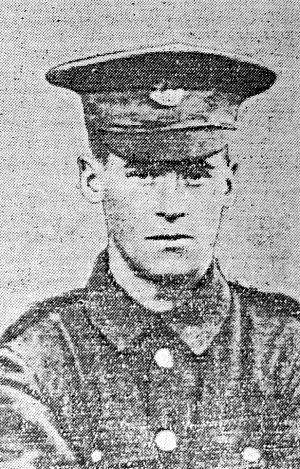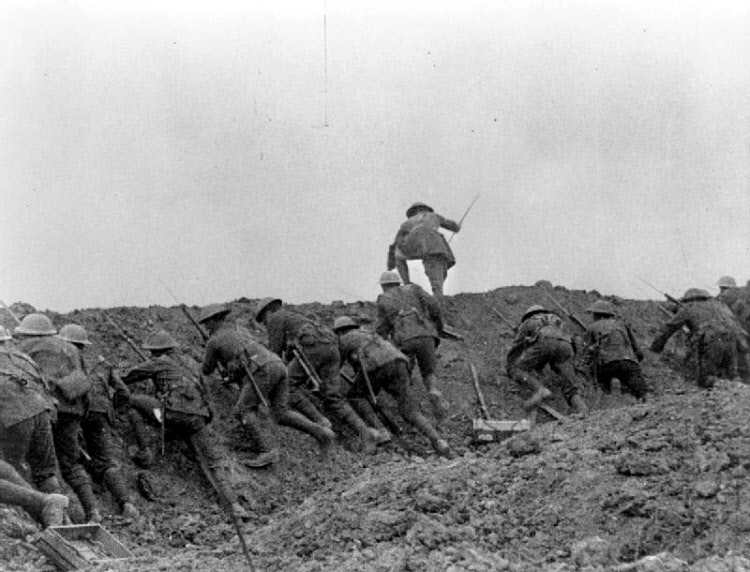
Charles Hewitt was born in Ossett in early 1890, the youngest child of Hemsworth-born Thomas Hewitt and his wife, County Down-born, Margaret (nee Marlow) who married in Newry, Ireland in 1871. The couple had eleven children, but sadly three children died before April 1911. The couple were living in Ossett by 1881, by which time Thomas was a general labourer living next to, and possibly working for, Abraham Pollard at Longlands House, Flushdyke. Thomas and Margaret have five children by this time, the eldest born in 1873, in Ossett, suggesting that the couple had moved to Ossett in the early 1870s shortly after their marriage.
By 1891, the Hewitt family had moved across town to South Parade, where Charles was probably born. Thomas Hewitt was now working as a wool extractor and in 1901 Thomas and his family had moved to nearby Haggs Hill Road when Thomas was working as a carter for Ossett Corporation. Charles Hewitt, now aged 11, was at school.
Thomas Hewitt died in 1903, and in 1911 Charles, aged 21, was living with his widowed mother, a brother, Harry aged 23, and a sister Kate aged 28 at a three-roomed house at 3, Haggs Hill Road, Ossett. Harry and Charles were both pony drivers at the nearby Roundwood Pit.
10th (Service) Battalion, KOYLI was formed at Pontefract in September 1914 as part of K3 and came under command of 64th Brigade in 21st Division. The Battalion moved to Berkhamsted and then to Halton Park (Tring) in October 1914, going on to billets in Maidenhead in November. They returned to Halton Park in April 1915 and went on to Witley in August. In September 1915, they landed in France. on the 13th February 1918 the battalion was disbanded in France, with at least some of the men going to 20th Entrenching Battalion.
Charles Hewitt’s army service record has not survived, but it is known that he enlisted at Ossett and that he embarked for France on 11th September 1915 thereby qualifying for the 1914/15 Star medal awarded for overseas service before 31st December 1915. He was posthumously awarded the this medal and the British and Victory medals for his service.
The 10th KOYLI were involved in the attack on Fricourt on the opening day of the Battle of the Somme on the 1st July 1916 as part of 64 Brigade, 21st Division. The 64th (Northern Brigade) in 21 Division consisted of the 9th and 10th Kings Own Yorkshire Light Infantry (KOYLI) in the front line, with the 15th Battalion Durham Light Infantry (DLI) and the 1st Battalion East Yorkshire Regiment in reserve.
The 10th Battalion, KOYLI war diary for the 1st July 1916 is very brief:
“The British offensive commenced, this battalion leading the 64th Brigade assault. They left the trenches at 7.30 a.m. and took Crucifix Trench that morning and held it till early the next day, when they were relieved by the 1st Lincolns. Casualties – Officers Killed: Capt. C.R. Heygate, Lt. J.W. Bamber, Lt. R.S.M. Beatson, 2nd Lt. J. Andrew, 2nd Lt. K.J.P. Asher, 2nd Lt. A.C. Cockroft, 2nd Lt. J.A.A. Fountain, 2nd Lt. M.E.J. Maude, 2nd Lt. L.F. Sharp, 2nd Lt. G.F.N. Wilkinson. Wounded 16 Other Ranks Killed 50, Wounded 292, Missing 135.” Those missing including Private Charles Hewitt.
Prior to Zero Hour (0730) the men from the KOYLI battalions (9th and 10th) crawled out into no man’s land in readiness for their assault. In front of them the German wire had been well cut by the week long artillery bombardment and both battalions made swift progress through the German’s front line trenches. Within 30 minutes they had secured an area around the north of Fricourt village as far as the road to Contalmaison. Here they were held by machine gun fire coming from their front and flanks, and dug in. To their left the 34th Division’s attempt at taking La Boisselle had been repulsed with enormous loss to its Tyneside Brigades. As the 34th Division attempted to remedy the situation the KOYLI found themselves in the unenviable situation of maintaining a position surrounded on three sides.
The “Ossett Observer” 1 had this obituary for Private Charles Hewitt:
“Ossett Common Soldier Falls – Previously posted as wounded and missing, Private Charles Hewitt (26), of the King’s Own Yorkshire Light Infantry, an Ossett Common man, is now reported to have been killed in action at the beginning of the ‘big push’ on July 1st. The official intimation of his death was received during the weekend, by his brother, Mr. John Thomas Hewitt, of South-parade. The deceased, who was unmarried, was brought up at Ossett Common. His late father, a former corporation employee, himself spent many years in the army. A workman at Old Roundwood Collieries, deceased resided with a married sister at Roundwood at the time he enlisted, just over two years ago. He last visited home at Christmas 1914, and shortly afterwards went to the western front. For some time he had been a grenade thrower. His brother George, who went through the South African war, is engaged training recruits in the north of England.”

Above: British troops going ‘over the top’ on the opening day of the Battle of the Somme, 1st July 1916.
Private Charles Hewitt, aged 26 years, died on the 1st July 1916 and is remembered on Pier and Face 11 C and 12 A of the Thiepval Memorial,2 Somme, France. The Thiepval Memorial will be found on the D73, next to the village of Thiepval, off the main Bapaume to Albert road (D929).
On 1 July 1916, supported by a French attack to the south, thirteen divisions of Commonwealth forces launched an offensive on a line from north of Gommecourt to Maricourt. Despite a preliminary bombardment lasting seven days, the German defences were barely touched and the attack met unexpectedly fierce resistance. Losses were catastrophic and with only minimal advances on the southern flank, the initial attack was a failure. In the following weeks, huge resources of manpower and equipment were deployed in an attempt to exploit the modest successes of the first day. However, the German Army resisted tenaciously and repeated attacks and counter attacks meant a major battle for every village, copse and farmhouse gained. At the end of September, Thiepval was finally captured. The village had been an original objective of 1 July. Attacks north and east continued throughout October and into November in increasingly difficult weather conditions. The Battle of the Somme finally ended on 18 November with the onset of winter.
In the spring of 1917, the German forces fell back to their newly prepared defences, the Hindenburg Line, and there were no further significant engagements in the Somme sector until the Germans mounted their major offensive in March 1918.
The Thiepval Memorial, the Memorial to the Missing of the Somme, bears the names of more than 72,000 officers and men of the United Kingdom and South African forces who died in the Somme sector before 20 March 1918 and have no known grave. Over 90% of those commemorated died between July and November 1916. The memorial also serves as an Anglo-French Battle Memorial in recognition of the joint nature of the 1916 offensive and a small cemetery containing equal numbers of Commonwealth and French graves lies at the foot of the memorial.
The dead of other Commonwealth countries, who died on the Somme and have no known graves, are commemorated on national memorials elsewhere.
References:
1. “Ossett Observer”, 19th August 1916